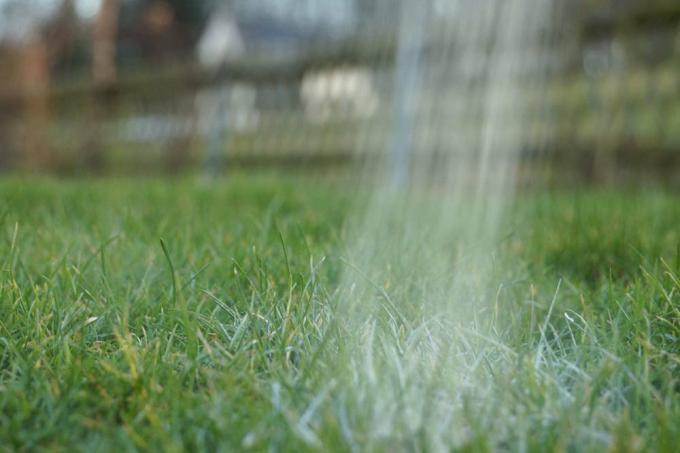
table of contents
- Fertilize the lawn
- Apply fertilizer correctly
- Fertilize but not rain - what to do?
A beautiful green lawn carpet is the flagship of every garden plot. In order for the green area to be and remain nice and dense and green, the supply of additional nutrients is necessary. This happens normally via fertilization with special lawn fertilizer, which has been tailored precisely to the needs of the lawn. There are a few things to consider when applying. The opinion is widespread that only fertilize when it rains. Does it really have to rain to be able to fertilize?
Fertilize the lawn
As a rule, a lawn should be fertilized three times a year:
- in March / April
- end of June
- Mid October
In the Spring fertilization the use of a long-term lawn fertilizer is recommended. This slowly releases the nutrients to the grass plants for up to six months. Spreading after the first mowing is ideal.
the Autumn fertilization should be done with a potassium-based fertilizer. This makes the grass hardy.
Note: A good lawn fertilizer must be optimally tailored to the needs of the lawn. It should contain the main nutrients nitrogen, phosphorus and potassium.
Apply fertilizer correctly
The fertilizer must always be applied evenly to the lawn. There must be no overlap. Liquid fertilizer can easily be spread with the watering can or with an automatic irrigation system. It is important that the dosage is observed. Otherwise it can quickly lead to over-fertilization, because the plants only take in as much nutrients as they need. Not just that race would be damaged, but the remaining fertilizer simply ends up in the groundwater, which is not exactly environmentally friendly. It should also be noted
- Application only on dry lawn
- On wet lawns, fertilizers stick to stalks
- Burns can occur if fertilizers with a high concentration of nitrogen are used
- Fertilization in the evening is ideal
- Fertilizer should not be left on the plants
- Soaking recommended

tip: A spreader or basket should be used to spread the fertilizer. This guarantees even spreading.
Fertilize but not rain - what to do?
Experts always advise fertilizing the lawn when rain is in sight. Unfortunately, the weather doesn't always play along, especially in the hot summers of recent years. But no problem. Irrigation of the lawn can be a very simple solution.
- recommended to water the area for 20 to 30 minutes after fertilization
- Watering should be repeated after one to two days
- This allows plants to form deeper roots
- especially advantageous during dry periods
- Irrigation with watering can, garden hose or automatic irrigation system possible
The situation is different, however, when using lawn fertilizer with a weed killer. The lawn should already be damp, so water it beforehand. The best effect is achieved if the fertilizer sticks to the plants, including weeds, for one to two days. Irrigation should only take place two to three days after application.
Note: A healthy lawn of 250 m² provides the oxygen requirements for a family of four every day during its growth phase.

Why is it watering?
All plants, including grass plants, can only absorb nutrients in dissolved form. By watering after fertilization, the fertilizer is washed into the sward. In the process, the nutrients dissolve, reach the soil more quickly and can be absorbed by the plants unhindered. In other words, the fertilizer can develop its effect more quickly, which is then also quickly visible.
tip: However, watering after fertilizing the lawn is not absolutely necessary. However, you should bear in mind that prolonged dry weather will delay the effect of the fertilizer.

